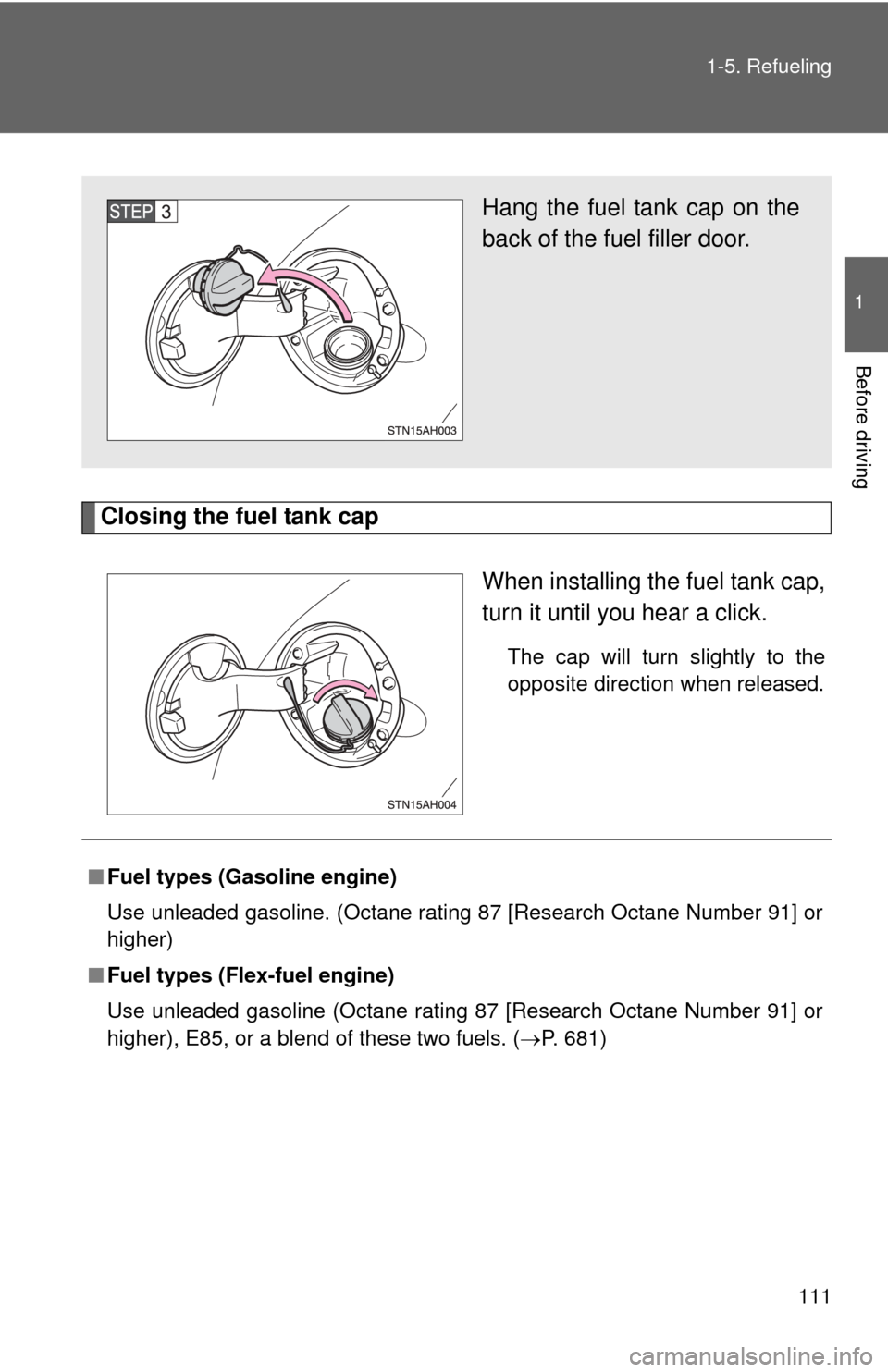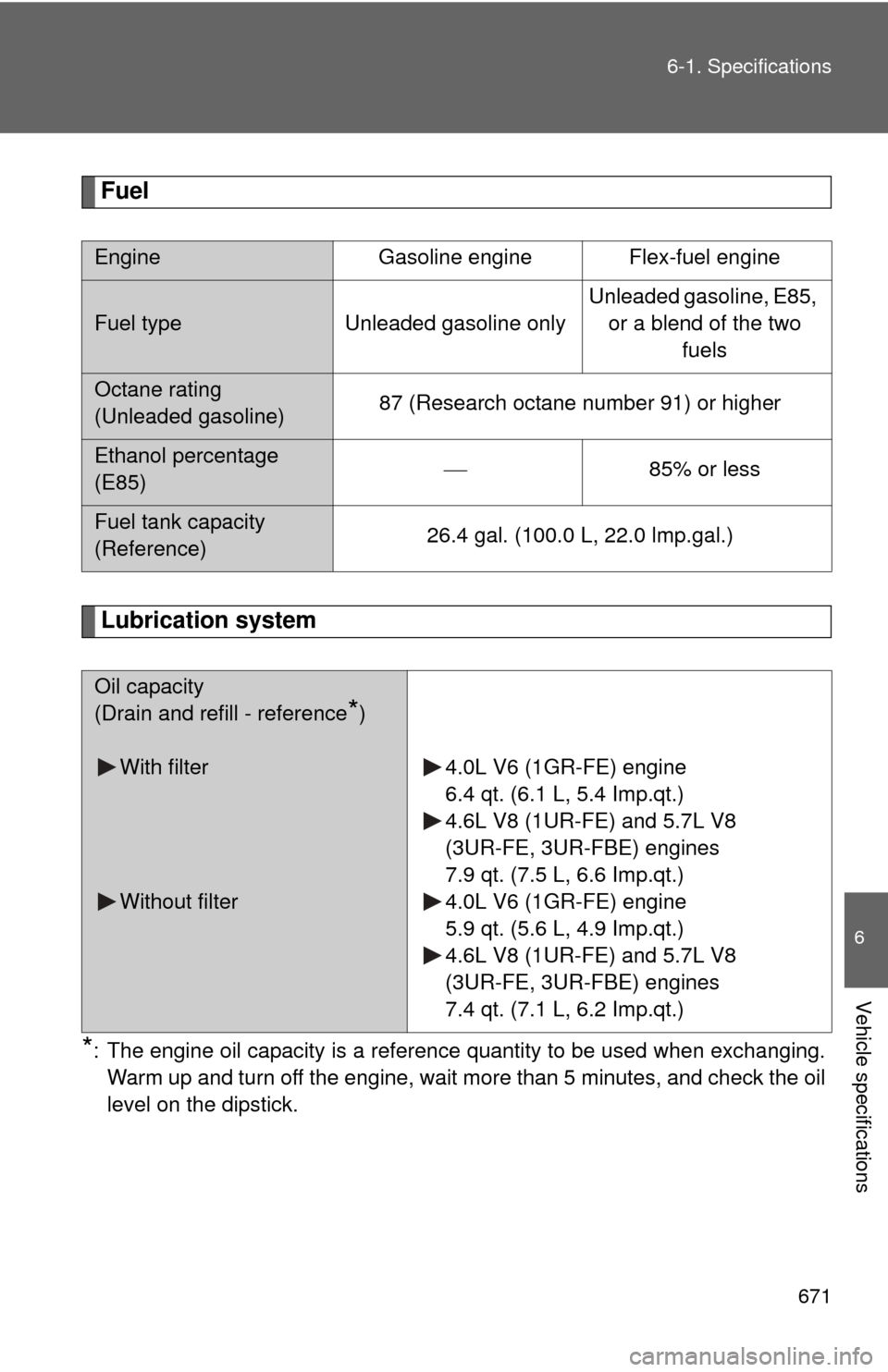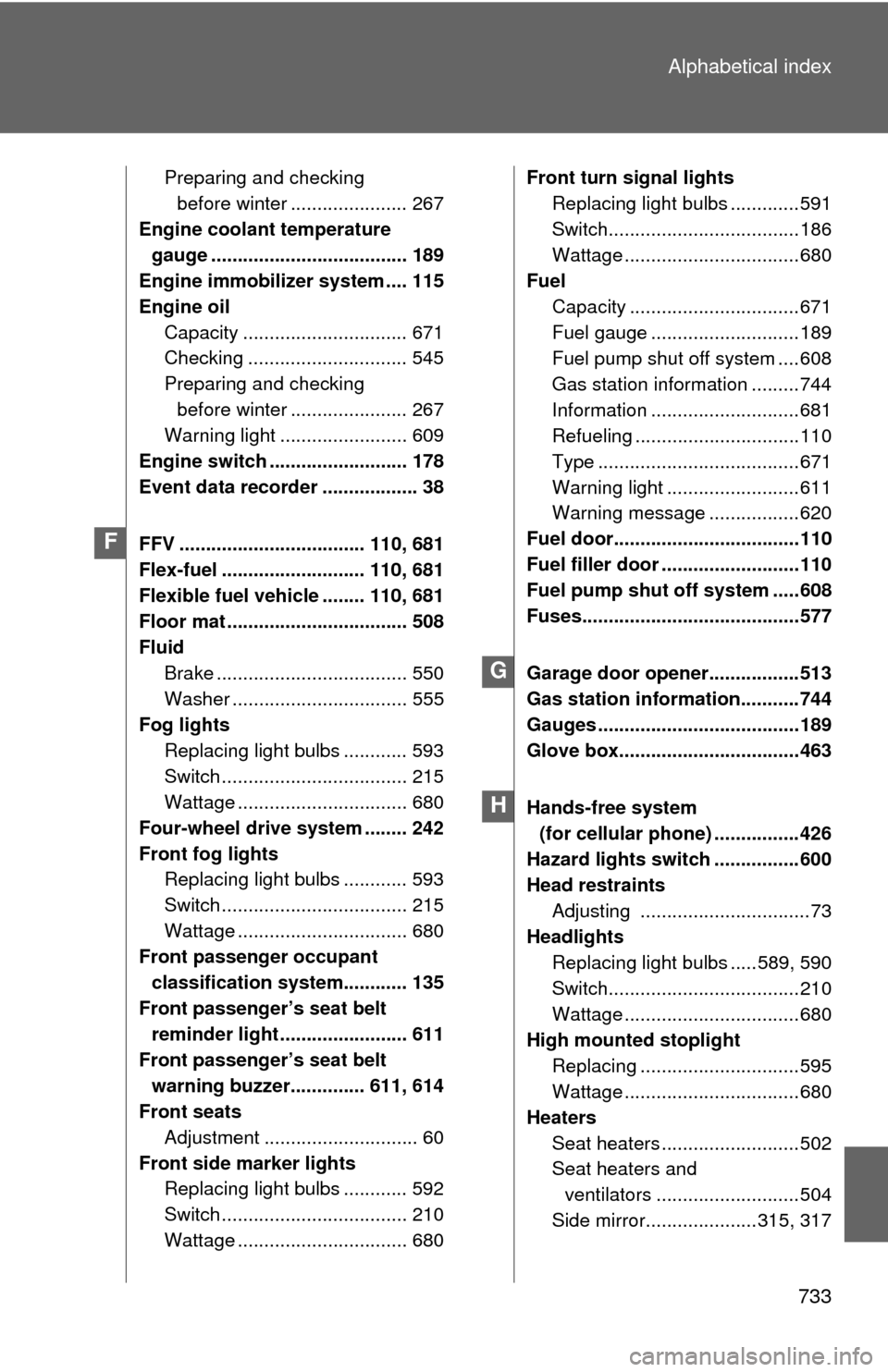2012 TOYOTA TUNDRA gas type
[x] Cancel search: gas typePage 111 of 744

111
1-5. Refueling
1
Before driving
Closing the fuel tank cap
When installing the fuel tank cap,
turn it until you hear a click.
The cap will turn slightly to the
opposite direction when released.
Hang the fuel tank cap on the
back of the fuel filler door.
■Fuel types (Gasoline engine)
Use unleaded gasoline. (Octane rating 87 [Research Octane Number 91] or
higher)
■ Fuel types (Flex-fuel engine)
Use unleaded gasoline (Octane rating 87 [Research Octane Number 91] or
higher), E85, or a blend of these two fuels. ( P. 681)
Page 124 of 744

124 1-7. Safety information
Your vehicle is equipped with ADVANCED AIRBAGS designed based
on US motor vehicle safety standards (FMVSS208). The airbag sys-
tem controls airbag deployment power for the driver and right front
passenger. The driver airbag system consists of the driver seat’s
position sensor etc. The front pass enger’s airbag system consists of
the front passenger occupant classification sensor etc.
The main SRS airbag system components are shown above. The
SRS airbag system is controlled by the airbag sensor assembly. The
airbag sensor assembly consists of a safing sensor and an airbag
sensor.
Front bench type seat: The SRS airbags are designed to protect the
driver and right front passenger, and they are not designed to protect
an occupant in the front center seating position.
In certain types of severe frontal or side impacts, the SRS airbag sys-
tem triggers the airbag inflators. A chemical reaction in the inflators
quickly fills the airbags with non-toxic gas to help restrain the motion
of the occupants. Side airbags
AIR BAG ON and AIR BAG
OFF indicator lights
Curtain shield airbags
Front passenger airbag
Knee airbags
Side and curtain shield air-
bag sensors
Front airbag sensors
Airbag sensor assembly
Curtain shield airbag sen-
sors (Double Cab and
CrewMax models)
Front passenger’s seat belt
buckle switch
Occupant detection system
(ECU and sensors)
SRS warning light and
RSCA OFF indicator light
RSCA OFF switch
(4WD models only)
Driver’s seat position sen-
sor
Driver airbag
Driver’s seat belt buckle
switch
Page 174 of 744

174 2-1. Driving procedures
CAUTION
■When the vehicle is parked
●If the shift lever is moved before the 4LO indicator turns on/off, the transfer
mode may not be shifted completely. The transfer mode disengages both
the front and rear driveshafts from the powertrain and allows the vehicle to
move regardless of the shift position. (At this time, the indicator blinks and
the buzzer sounds.)
Therefore, the vehicle is free to roll even if the automatic transmission is in
P. You or someone else could be seriously injured. You must complete the
shifting of the transfer mode. ( P. 244)
● Do not touch the exhaust pipe while the engine is running or immediately
after turning the engine off.
Doing so may cause burns.
● Do not leave the engine running in an area with snow build-up, or where it
is snowing. If snowbanks build up around the vehicle while the engine is
running, exhaust gases may collect and enter the vehicle. This may lead
to death or a serious health hazard.
■ Exhaust gases
Exhaust gases include harmful carbon monoxide (CO) that is colorless and
odorless. Inhaling exhaust gases may lead to death or a serious health haz-
ard.
●If the vehicle is in a poorly ventilated area, stop the engine. In a closed
area, such as a garage, exhaust gases may collect and enter the vehicle.
This may lead to death or a serious health hazard.
● The exhaust should be checked occasionally. If there is a hole or crack
caused by corrosion, damage to a joint or abnormal exhaust noise, be
sure to have the vehicle inspected and repaired by your Toyota dealer.
Failure to do so may allow exhaust gases to enter the vehicle, resulting in
death or a serious health hazard.
● Toyota does not recommend occupying the rear cargo area when it is fitted
with a slide-in camper, camper shell or other type cover while the engine is
running. This caution applies to bot h driving and stopped or parked situa-
tions with the engine running. Particular care should be taken to prevent
exhaust gases from entering camper bodies, trailers or other enclosures
on or around your vehicle. If exhaust fumes are detected, open all win-
dows and thoroughly ventilate the area.
Page 670 of 744

670 6-1. Specifications
Engine4.0L V6 (1GR-FE) engine
4.6L V8 (1UR-FE) and 5.7L V8 (3UR-FE, 3UR-FBE) engines
Model 1GR-FE
Type 6-cylinder V-type, 4-cycle, gasoline
Bore and stroke 3.70 3.74 in. (94.0 95.0 mm)
Displacement 241.4 cu.in. (3956 cm3)
Drive belt tension Automatic adjustment
Valve clearance
(engine cold) Automatic adjustment
Model
1UR-FE, 3UR-FE, 3UR- FBE
Type 8-cylinder V-type, 4-cycle, gasoline
Bore and stroke 4.6L V8 (1UR-FE) engine
3.70
3.27 in. (94.0 83.0 mm)
5.7L V8 (3UR-FE, 3UR-FBE) engine
3.70 4.02 in. (94.0 102.0 mm)
Displacement 4.6L V8 (1UR-FE) engine
281.2 cu.in. (4608 cm3)
5.7L V8 (3UR-FE, 3UR-FBE) engine
345.6 cu.in. (5663 cm
3)
Drive belt tension Automatic adjustment
Valve clearance
(engine cold) Automatic adjustment
Page 671 of 744

671
6-1. Specifications
6
Vehicle specifications
Fuel
Lubrication system
*: The engine oil capacity is a reference quantity to be used when exchanging.
Warm up and turn off the engine, wait more than 5 minutes, and check the oil
level on the dipstick.
Engine Gasoline engine Flex-fuel engine
Fuel typeUnleaded gasoline onlyUnleaded gasoline, E85,
or a blend of the two fuels
Octane rating
(Unleaded gasoline) 87 (Research octane number 91) or higher
Ethanol percentage
(E85)
85% or less
Fuel tank capacity
(Reference) 26.4 gal. (100.0 L, 22.0 lmp.gal.)
Oil capacity
(Drain and refill - reference
*)
With filter
Without filter 4.0L V6 (1GR-FE) engine
6.4 qt. (6.1 L, 5.4 Imp.qt.)
4.6L V8 (1UR-FE) and 5.7L V8
(3UR-FE, 3UR-FBE) engines
7.9 qt. (7.5 L, 6.6 Imp.qt.)
4.0L V6 (1GR-FE) engine
5.9 qt. (5.6 L, 4.9 Imp.qt.)
4.6L V8 (1UR-FE) and 5.7L V8
(3UR-FE, 3UR-FBE) engines
7.4 qt. (7.1 L, 6.2 Imp.qt.)
Page 683 of 744

683
6-1. Specifications
6
Vehicle specifications
■
Toyota recommends the use of cleaner burning gasoline
Cleaner burning gasoline, including reformulated gasoline that contains oxy-
genates such as ethanol or MTBE (Methyl Tertiary Butyl Ether) is available in
many areas.
Toyota recommends the use of cleaner burning gasoline and appropriately
blended reformulated gasoline. These types of gasoline provide excellent
vehicle performance, reduce vehicle emissions and improve air quality.
■ Toyota does not recommend blended gasoline (Gasoline engine)
●Toyota allows the use of oxygenate blended gasoline where the oxygen-
ate content is up to 10% ethanol or 15% MTBE.
● If you use gasohol in your Toyota, be sure that it has an octane rating no
lower than 87.
● Toyota does not recommend the use of gasoline containing methanol.
■ Toyota does not recommend gasoline containing MMT
Some gasoline contains octane enhancing additive called MMT (Methylcy-
clopentadienyl Manganese Tricarbonyl).
Toyota does not recommend the use of gasoline that contains MMT. If fuel
containing MMT is used, your emission control system may be adversely
affected.
The malfunction indicator lamp on the instrument cluster may come on. If
this happens, contact your Toyota dealer for service.
■ Toyota does not recommend blended gasoline (Flex-fuel engine)
Do not use non-specified fuels such as the following.
• Fuels containing methanol.
• Fuels with more than 85% ethanol.
■ Toyota does not recommend the use of after-market fuel additives
(Flex-fuel engine)
Do not use any after-market fuel additives when repeatedly refueling with
E85, as some after-market fuel additives are not compatible with E85.
Page 684 of 744

684 6-1. Specifications
NOTICE
■Notice on fuel quality
●Do not use improper fuels.
If improper fuels are used the engine will be damaged.
● Do not use leaded gasoline.
Leaded gasoline can cause damage to your vehicle’s three-way catalytic
converters causing the emission control system to malfunction.
● Gasoline engine: Do not use gasohol other than that stated here.
Other gasohol may cause fuel system damage or vehicle performance
problems.
● Use of unleaded gasoline with an octane rating lower than 87 may result in
engine knocking. Persistent knocking can lead to engine damage and
should be corrected by refueling with higher octane unleaded gasoline.
■ When use of non-specified fuels (Flex-fuel engine)
The use of non-specified fuels will have a negative impact on starting and
driving performance, and will cause damage to the fuel system components.
Therefore, do not add fuels such as the following.
• Fuels containing methanol
• Fuels with more than 85% ethanol
■ Fuel-related poor driveability
If after using a different type of fuel, poor driveability is encountered (poor
hot starting, vaporization, engine knocking, etc.), discontinue the use of that
type of fuel.
■ When refueling
Take care not to spill fuel.
It can damage your vehicle’s paint.
Page 733 of 744

733
Alphabetical index
Preparing and checking
before winter ...................... 267
Engine coolan t temperature
gauge ..................................... 189
Engine immobilizer system .... 115
Engine oil
Capacity ............................... 671
Checking .............................. 545
Preparing and checking before winter ...................... 267
Warning light ........................ 609
Engine switch .......................... 178
Event data recorder .................. 38
FFV ................................... 110, 681
Flex-fuel ........................... 110, 681
Flexible fuel vehicle ........ 110, 681
Floor mat .................................. 508
Fluid Brake .................................... 550
Washer ................................. 555
Fog lights
Replacing light bulbs ............ 593
Switch ................................... 215
Wattage ................................ 680
Four-wheel drive system ........ 242
Front fog lights Replacing light bulbs ............ 593
Switch ................................... 215
Wattage ................................ 680
Front passenger occupant
classification system............ 135
Front passenger’s seat belt reminder light ........................ 611
Front passenger’s seat belt warning buzzer.............. 611, 614
Front seats
Adjustment ............................. 60
Front side marker lights Replacing light bulbs ............ 592
Switch ................................... 210
Wattage ................................ 680 Front turn signal lights
Replacing light bulbs .............591
Switch....................................186
Wattage .................................680
Fuel
Capacity ................................671
Fuel gauge ............................189
Fuel pump shut off system ....608
Gas station information .........744
Information ............................681
Refueling ...............................110
Type ......................................671
Warning light .........................611
Warning message .................620
Fuel door...................................110
Fuel filler door ..........................110
Fuel pump shut off system .....608
Fuses.........................................577
Garage door opener.................513
Gas station information...........744
Gauges ......................................189
Glove box..................................463
Hands-free system (for cellular phone) ................426
Hazard lights switch ................600
Head restraints
Adjusting ................................73
Headlights
Replacing light bulbs .....589, 590
Switch....................................210
Wattage .................................680
High mounted stoplight Replacing ..............................595
Wattage .................................680
Heaters Seat heaters ..........................502
Seat heaters and ventilators ...........................504
Side mirror.....................315, 317
F
G
H